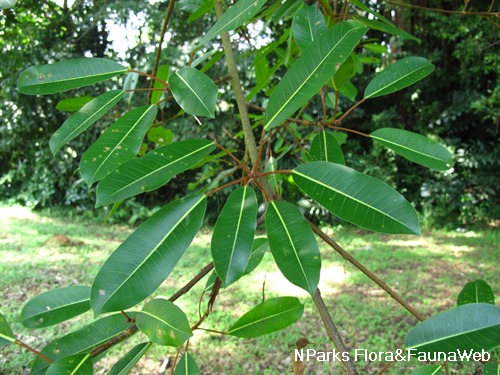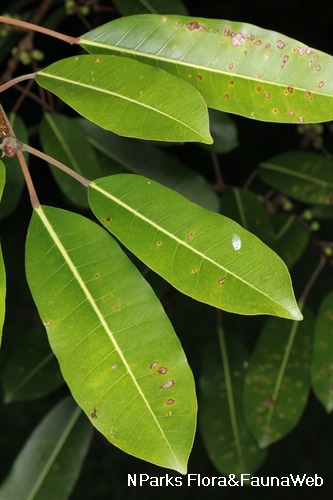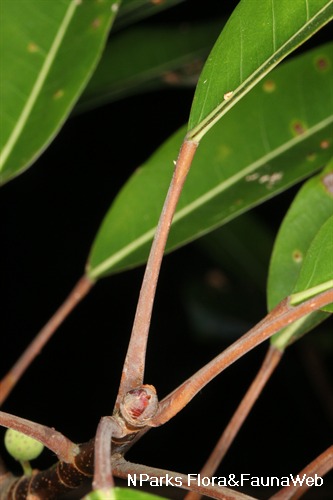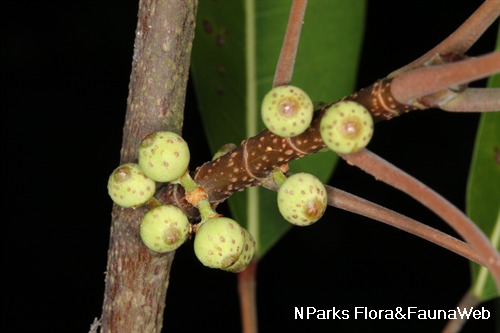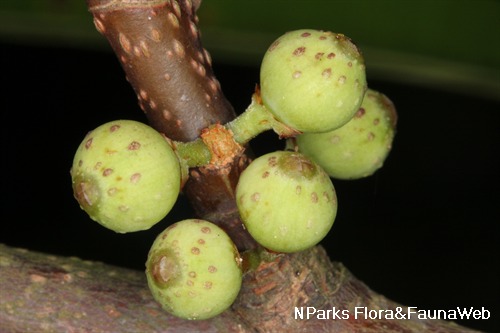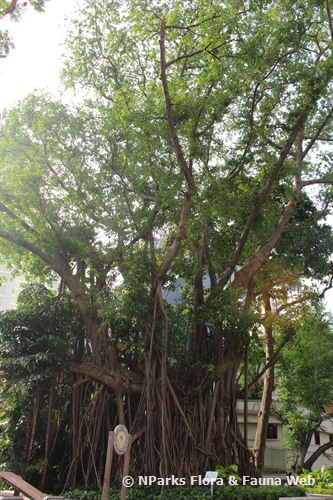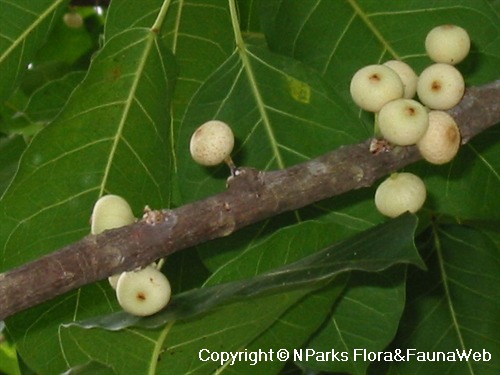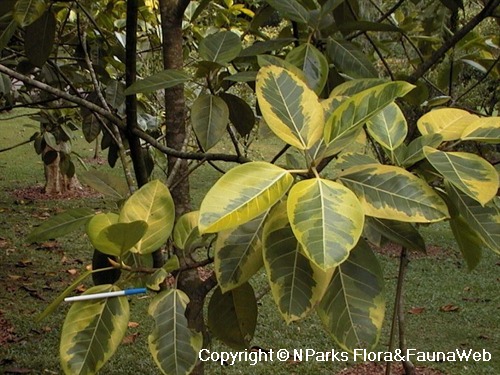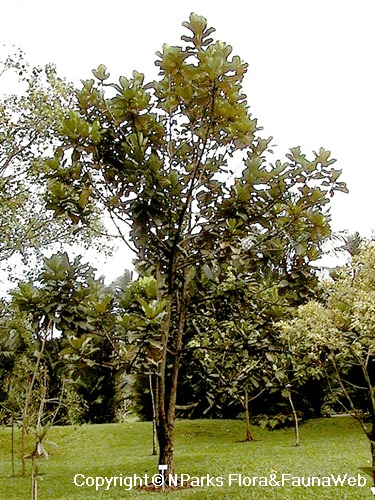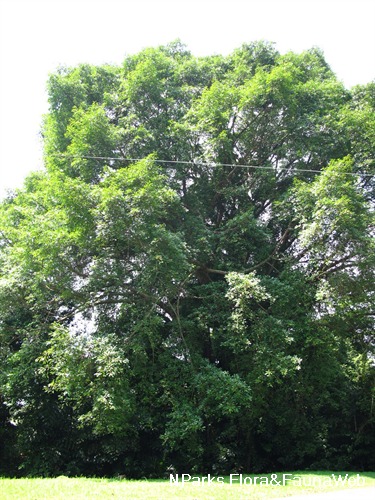
Name
Classifications and Characteristics
| Plant Division | Angiosperms (Flowering Seed Plants) (Dicotyledon) |
|---|---|
| Plant Growth Form | Tree (Big (>30m)) |
| Lifespan (in Singapore) | Perennial |
| Mode of Nutrition | Autotrophic |
| Plant Shape | Umbrella |
| Maximum Height | 35 m |
Biogeography
| Native Distribution | Sri Lanka, Myanmar, Thailand, Ryuku Islands, Taiwan, Peninsular Malaysia, Singapore, Sumatra, Java, Lesser Sunda Islands, Borneo, the Philippines, Celebes, Moluccas, New Guinea. |
|---|---|
| Native Habitat | Terrestrial |
| Preferred Climate Zone | Tropical |
| Local Conservation Status | Native to Singapore (Endangered (EN)) |
Description and Ethnobotany
| Growth Form | It is a large, latex-containing, strangling fig up to 20 (- 35) m tall. |
|---|---|
| Crown | Its crown is umbrella-shaped. |
| Foliage | Its alternate, stalked leaves have thin leathery leaf blades that are 6-19 by 2-7.5 cm. The petioles are reddish brown when young. |
| Flowers | Its tiny staminate (male) and pistillate (female) flowers are borne inside a specialised structure known as a syconium (fig). |
| Fruit | Its round syconia (figs) are 6 mm wide, and develop singly, in pairs, or in stalked clusters up to 8 on the twigs. They are whitish with pink spots, and ripen greyish purple then blackish. |
| Habitat | It grows in coastal and inland forests up to 1,300 m, and on roadside trees, starting as an epiphyte. |
| Associated Fauna | Its flowers are pollinated by fig wasps. The fruits are eaten by birds. |
| Cultivation | It can be propagated by seed, stem cutting or air-layering. |
| Etymology | Latin Ficus, the commercial edible fig (Ficus carica), Latin caulocarpa, stalked fruit, referring to the stalked figs of this species. |
| Ethnobotanical Uses | Cultural / Religious: Heritage Trees : There are currently 2 individuals of Ficus caulocarpa listed as a Heritage Tree in Singapore. One can be found at Hendon Road while the other is found at Winchester Road. To find out more about these trees, please visit the Heritage Tree Register. |
Landscaping Features
| Landscaping | It is a striking large treewith large leaves (somewhat similar to the Johorfi g, Ficus kerkhovenii), suitable for large gardens or parks. |
|---|---|
| Desirable Plant Features | Ornamental Form |
| Landscape Uses | General, Parks & Gardens, Coastal, Shade Providing Tree / Palm, Reforestation |
| Thematic Landscaping | Naturalistic Garden, Bird & Wildlife Garden |
Fauna, Pollination and Dispersal
| Fauna Pollination Dispersal Associated Fauna | Bird-Attracting, Caterpillar Moth Food Plant |
|---|---|
| Pollination Method(s) | Biotic (Fauna) |
| Seed or Spore Dispersal | Biotic (Fauna) |
Plant Care and Propagation
| Light Preference | Full Sun, Semi-Shade |
|---|---|
| Water Preference | Moderate Water |
| Plant Growth Rate | Moderate |
| Rootzone Tolerance | Moist Soils, Well-Drained Soils, Fertile Loamy Soils, Easy to Grow |
| Propagation Method | Seed, Stem Cutting (Softwood), Air-Layering |
Foliar
| Foliage Retention | Deciduous |
|---|---|
| Mature Foliage Colour(s) | Green |
| Mature Foliage Texture(s) | Leathery, Thin |
| Foliar Type | Simple / Unifoliate |
| Foliar Arrangement Along Stem | Alternate |
| Foliar Attachment to Stem | Petiolate |
| Foliar Shape(s) | Non-Palm Foliage (Elliptical) |
| Foliar Venation | Pinnate / Net |
Non - Foliar and Storage
| Trunk Type (Non Palm) | Woody |
|---|---|
| Root Type | Underground, Aboveground (Aerial Root, Strangling Root) |
Floral (Angiosperm)
| Flower & Plant Sexuality | Unisexual Flowers , Monoecious |
| Flower Grouping | Cluster / Inflorescence |
|---|
| Flower Location | Cauliflorous |
| Inflorescence Type | Syconium |
Fruit, Seed and Spore
| Mature Fruit Colour(s) | Black, Purple |
|---|---|
| Fruit Classification | Multiple Fruit |
| Fruit Type | Fleshy Fruit , Accessory / False Fruit (Pseudocarp) |
References
| References | Tan, P.Y., R.T. Corlett and H.T.W. Tan (Editors). 2010. A Field Guide to the Native Garden @ HortPark: an Urban Oasis of the Native Flora and Fauna of Singapore. Singapore: Centre for Urban Greenery and Ecology (National Parks Board) and National University of Singapore. 124pp |
|---|
Image Repository
Others
| Master ID | 29864 |
|---|---|
| Species ID | 4173 |
| Flora Disclaimer | The information in this website has been compiled from reliable sources, such as reference works on medicinal plants. It is not a substitute for medical advice or treatment and NParks does not purport to provide any medical advice. Readers should always consult his/her physician before using or consuming a plant for medicinal purposes. |

